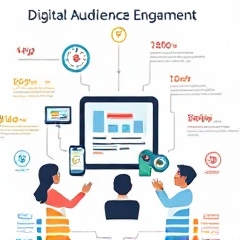Review of the book “Business Website: How to Find Customers and Increase Sales” — Mikhail Khristosenco. About attracting clients via the Internet
Main ideas:
- A website is a guide.
- Real-life examples of increased revenue.
- SEO is a real tool for attracting customers.
- Small details can double conversion.
- Instructions with real results.
If your website still resembles an old closet in the attic — this book will definitely give you a reason to dust it off and finally make it work for you.
Key Concepts and Their Analysis

The author's meticulous attention to detail is what turns his analysis into something more than a dry instruction on "adjusting buttons." He step by step reveals the inner workings of dealing with a digital audience:
- No abstract slogans about progress, but clear strategies.
- The forefront is occupied by the ability to make a page yield results.
It was especially impressive how consistently the role of search engine promotion and meaningful content is revealed - there is no room for magic here:
- Khristosenko insists that without understanding key queries and analyzing visitor behavior, no tricks will help turn a random guest into a regular client.
The author doesn't get away with general phrases, but offers specific solutions and even analyzes mistakes that are commonplace:
- When you see how dry formulas hide real practice, you can't help but think: how many opportunities have already been missed due to banal inattention to detail?
The text doesn't indulge the reader with promises of easy victories, but arms them with quite practical techniques that can be implemented without excessive pangs of conscience - and this is perhaps the main value of all the concepts presented.
Who is the book for
It is quite revealing that the main audience of this book is not theoretical experts, but those who face the task daily:
- how to turn their online corner into a real magnet for new clients.
Here, the focus is not on "gray cardinals" of IT or meticulous marketers with decades of experience behind them - the author addresses primarily:
- small business owners,
- managers,
- start-uppers,
who have no time or desire to drown in a sea of abstractions, but have a keen interest in clear and working tools. The entire narrative is imbued with respect for the person of action:
- solutions are prescribed taking into account a limited budget,
- and constant time pressure,
- and the analysis of typical mistakes is not a lecture for students, but rather a friendly nudge towards change.
While reading, you get the feeling that the author himself has been through these experiences and is now honestly sharing his expertise to save others from unnecessary disappointments.
It is precisely for those who today struggle for every application and try to understand why the website is a dead weight and does not bring real returns, that this guide will become not just a help, but a workbook for daily use.
About the author and his significance in marketing

The author of this manual is not an armchair dreamer, but a person who is familiar with the anxieties and joys of entrepreneurs firsthand:
- Mikhail Khristenko has long been considered one of those specialists whose recommendations do not hover in the clouds, but are based on a solid practical foundation.
- His name regularly appears at industry conferences and in leading publications.
- People read his publications not out of idle curiosity, but to understand how to really increase the influx of customers in an era when competition for customer attention is like a battle for survival.
- Khristenko is not afraid to talk about failures and difficulties, which immediately inspires trust.
- Here you can feel an honest conversation "without embellishments".
- Thanks to his personal experience and respect for the people to whom the book is addressed, its creator is perceived not as another guru, but as a comrade-in-arms in the difficult struggle for results.
The Place of the Book in Modern Marketing Literature
Against the backdrop of endless "magic pills" and manuals promising gold mountains in three steps, this work stands out not only for its sanity but also for its rare ability to connect dry schemes with real pains and business tasks.
In a world where most similar books drown in talk about "lead generation" without the slightest hint of specificity, Khristosyenko manages not to slide into banal generalizations:
- Each recommendation is like a shot on target, not just another line in a checklist.
That's why the work is in demand among those who:
- Don't look for easy ways
- Are tired of fruitless promises
This is not another run-of-the-mill product, but a guide that ranks alongside truly working tools of modern marketing.
It's also important that the author doesn't get carried away with excessive theorization:
- There's no dust from textbooks or high-flown reasoning "out of the blue".
Everything is aimed at enabling the reader to apply the idea today and get the first result tomorrow.
| Criteria | The Work | Similar Books |
|---|---|---|
| Connection between theory and practice | ||
| Concrete recommendations | ||
| Excessive theorization |
Relevance of the publication at the current moment

In a world where digital space is filled with templated instructions and loud promises of quick miracles, it's hard to find a guide that can withstand even a superficial test of strength. It's against this backdrop that the author's approach is perceived as a breath of fresh air: here you won't find recipes detached from reality or vague formulas, and every idea seems to be tailored to the realities of today's market.
- While reading, you can't shake off the feeling that the author is speaking not just "for the sake of it", but as if they overheard entrepreneurs' conversations in the kitchen and presented them with unvarnished answers.
- It's especially valuable that the recommendations remain sharp even in the face of today's hyper-competition online:
- Emphasis on concrete steps
- Ability to prioritize between attracting an audience and real revenue growth
All of this turns the book into a tool that you want to keep handy, rather than putting it on a shelf for self-comfort.
Fundamental Marketing Concepts

If we discard all the fluff of pseudoscientific terms and endless “funnels”, we are left with the dry residue — the backbone on which this book is based:
- The author does not dazzle with loud words, but rather lays out the basic principles that actually work, regardless of the fashion for the next “lead generators”.
- Understanding the target audience is not an elective, but the foundation of any success.
- Competent positioning is directly related to revenue growth.
- No ready-made happiness pills are given; instead, the reader is guided through an analysis of real client requests.
- Attention is paid to the site structure and user scenario logic.
- A strong focus on measurable results.
This approach makes you rethink your view of familiar concepts:
- After a couple of chapters, you no longer want to blindly copy someone else's solutions.
- A healthy skepticism appears, along with a desire to get to the bottom of things.
And this, perhaps, is the author's key merit.
Innovative ideas and modern trends
But what really caught my attention — there's no infantile enthusiasm for new "features" and trendy buzzwords that every other info blog is full of nowadays: the author doesn't chase hype, but with surgical precision dissects the essence of today's trends.
- Instead of putting the reader to sleep with stories about "gamification" or imposing a cult of social networks, it's shown how to analyze user behavior not just for the sake of it, but to identify real growth drivers for business — with a specific focus on bounce rates, click maps, and feedback dynamics.
- This is where true innovation lies: not in blindly following the latest digital trends, but in being able to extract what's working here and now, without relying on yesterday's templates.
- The book is not about dogma — it's about meticulously adapting tools to one's niche, understanding why some solutions work and others just burn through the advertising budget.
- Such a perspective is not just refreshing, it brings back the feeling of real work to the profession, where technology serves a purpose, not the other way around.
Applicability of concepts in modern business
Assessing how well the proposed approaches fit into the realities of the modern market, I can’t help but note that the author manages to avoid ephemeral advice and abstract formulas, which are abundant in textbooks from the past decade. The focus is on specific steps and application logic: when discussing conversion, instead of a “magic button”, the entire user journey is broken down into the smallest details, from page loading speed to the structure of questions in feedback forms.
This pragmatic approach literally forces a re-examination of one's own templates: there's not a hint of “universal recipes”, only fine-tuning of tools to suit the tasks at hand. It's especially engaging that the recommendations are not detached from reality — they can be implemented today, without fear that they'll be just another theoretical checkbox.
There's no attempt to reinvent the wheel here: everything proposed is tested on real cases and adapted to our not always ideal market realities. This is not just a collection of ideas — it's a working tool that won't let you attribute failures to “industry specifics” or “bad weather in digital”.
Case studies and examples from real business
Analyzing the examples from practice, which the author generously illustrates in each chapter, you can't shake off the feeling that the described situations are taken from the shelves of domestic companies, rather than borrowed from glossy foreign case studies.
- Such stories are not just reassuring - they are like a cold shower, bringing you back to reality: beautiful slogans alone are not enough, you need painstaking work on every element.
- You don't feel like brushing off failures and attributing them to “the wrong market” or “product specifics”: both concise services and complex B2B giants are analyzed, and the conclusion is always the same - success can be measured if you're not afraid to dig into the details and tailor processes to your needs.
- This is a rare case when after reading a chapter, you don't want to flip further, but rather go and try it out before the enthusiasm wears off.
Strengths of the publication
But what really wins you over is its down-to-earth approach and specificity: instead of the usual abstractions and evasive promises, the reader gets clear, time-tested techniques that can be implemented as early as tomorrow.
The author doesn't get bogged down in vague discussions, but lays out working tools on the table:
- Page structuring
- Conversion optimization
- Collecting feedback
You won't find empty tips like “do good — things will be good” here: each suggestion is accompanied by an explanation of why it's needed and what specific result to expect.
It's especially pleasing that the recommendations aren't limited to some conditional internet giants — on the contrary, a lion's share of attention is paid to small and medium-sized companies, where budgets are modest, and every decision is put to the test.
As you read, it's like being on a working meeting with your sales department, where there's no room for pomp, but plenty of common sense and real steps. It's this practicality and lack of fluff that make the book an indispensable tool for those who are used to counting money and expecting returns on their invested efforts.
Critical analysis
However, there is a fly in the ointment: despite the detailed and elaborate explanations and an abundance of working tools, at times it feels like the author is overly repetitive, as if they are afraid that the reader won't grasp the main idea the first time.
- Life hacks for analyzing the target audience's needs are repeated from chapter to chapter, losing their freshness.
- Common truths are presented with excessive zeal, as if the reader is not a competent entrepreneur.
- There is a lack of challenge: more sharp corners and non-standard solutions are desired.
- The book is aimed at beginners; for experienced market players, there are too few fresh insights.
- The toolkit sometimes seems too conservative.
In the end, despite the clear benefits, at times there is a feeling of moving in circles, hoping to find a new door, only to end up at a familiar threshold.
Tools and techniques for practical use
At first glance, the set of working solutions in the book is impressive: checklists, step-by-step diagrams, structured algorithms — grab and implement them tomorrow. However, upon closer inspection, many of these "recipes" are clearly designed for those who have not yet learned to distinguish UTM tags from pop-ups: simplicity is presented as an advantage, but in reality, it sometimes slips into a banal repetition of truisms. The author methodically explains every detail, as if fearing that someone might stumble and forget to define their audience or not check the mobile version of the site. Yes, for beginners, this approach will be a lifesaver — step by step, without unnecessary fuss, everything is at hand. But if you've ever set up a target or launched a landing page, the edge is clearly not enough: you want fresh cases, non-standard tools, not just basic tips like "enable Google Analytics." At the same time, it cannot be denied — practical materials are systematized with a conscience, but truly breakthrough techniques that will make your heart beat faster are not to be found here.
- Advantages:
- Checklists
- Step-by-step diagrams
- Structured algorithms
- Disadvantages:
- Repetition of truisms
- No fresh cases
- Lack of edge
| Criterion | Pros | Cons |
|---|---|---|
| Convenience | ||
| For beginners | ||
| Innovations |
Popularity of the real edition

One of the strong sides of Mikhail Khristosenko's book is the examples from practice - not theoretical calculations, but specific cases illustrating how a business website can become a full-fledged sales channel.
The book describes real stories of companies that started with a minimal online presence, but thanks to the implementation of basic tools - a clear website structure, logical funnel, contact collection, and subsequent automation - reached a stable flow of clients.
- At the same time, the author honestly talks about the difficulties encountered along the way: distrust of online advertising, resistance of owners to changing the website, errors in positioning.
These cases are not idealized - they win over with their truth and demonstrate that even with a limited budget, you can achieve a tangible result if you follow a clear methodology and regularly test hypotheses.
Other works by the author
If we look at it from a broader perspective, it becomes clear that Mikhail Khristenko is not a newcomer to business literature, and this publication is just one of the building blocks in his coherent system of views on modern promotion methods.
Those who have already come across his previous works are familiar with the characteristic features of his style:
- Emphasis on practice
- Abundance of checklists, diagrams, and instructions
- Confidence that any business, whether it's a bakery around the corner or a startup from the provinces, can and should take digitalization tools into its own hands
In his previous publications, Khristenko analyzed in detail the topics of email marketing and conversion optimization, and he did it with the same meticulousness as this time. However, compared to his previous works, the book under discussion looks slightly less academic and much friendlier to the novice reader:
- Less dry theory
- Enough real-life stories
- Clear step-by-step algorithms
However, fans of in-depth analysis may feel a slight disappointment: the author seems to deliberately avoid complex cases and sharp corners, preferring to stay closer to the surface so as not to scare away the novice reader.
Comparison with other works by the author
If we recall Mikhail's previous works, it's easy to catch the characteristic intonations: pedantic detailing, a sea of instructions, and a strict commitment to measurable results. However, the fresh work stands out starkly against the background of his previous texts - like a teacher who has decided to switch from strict lectures to a lively dialogue with the audience.
- The cumbersome tables and abstruse schemes are gone;
- In their place are short stories, real-life situations, and clear, uncluttered recommendations.
It feels like the author has deliberately taken a step towards those who are just starting to take on the role of an entrepreneur - removing unnecessary theory, leaving only what can be taken and implemented tomorrow.
| Criterion | Old works | New work |
|---|---|---|
| Style | Pedantic | Dialogical |
| Structure | Cumbersome tables | Short stories |
| Approach | Theory | Practical advice |
Compared to his instructions on email marketing or guides on optimizing funnels, there's a sense of more ease and a desire to support, rather than overwhelm with the volume of material.
Perhaps, for fans of systematic, "on the shelves" analysis, this may seem like a simplification, but for those who are looking for a roadmap - it's just what the doctor ordered.
Similar literature by other authors
If you dig a little deeper and take a look around, you can instantly come across dozens of works by other recognized digital marketing gurus on the bookshelves - take at least the works of Denis Kaplunov or Aleksey Ivanov.
- Their approaches, as a rule, resemble a textbook on higher mathematics: formulas, checklists, flowcharts, and it seems that you can't do without a calculator and a couple of sleepless nights.
- Unlike this harsh academism, Khristoschenko seems to jettison the ballast of unnecessary words and numbers - instead of monumental page bricks, the reader gets a compact but rich guide.
- Each chapter is like a live hint, not just another chapter from a "thick" manual.
- Yes, the same Kaplunov has impeccable logic and textbook precision, but even his fresh editions are sometimes felt like a cycle of lectures for the initiated.
- Here, on the contrary, the material is presented with such ease that you want to immediately get to work - and not be afraid to make a mistake.
- Compared to the heavyweight works of colleagues, this work suddenly turns out to be closer to the real concerns of small businesses and those who are just trying their hand at online promotion, without wanting to drown in theoretical thickets.
Mikhail Khristoschenko's book is not a set of loud slogans, but a truly practical guide that can breathe life into a business website even with a minimal budget. The author speaks to the reader in the same language, shares working tools and returns the feeling that digital marketing is a craft, not magic. That is why the publication will be useful to everyone who expects to attract clients from the site.
